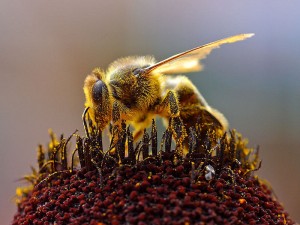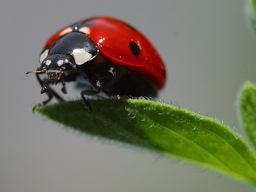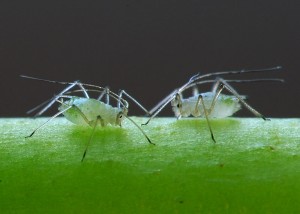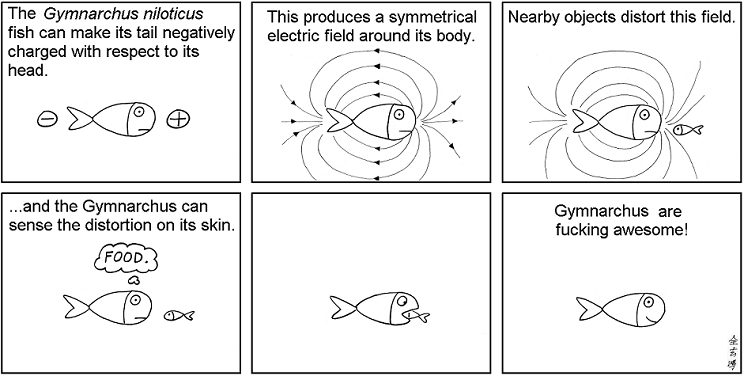 I thought I’d made the case against parasitic wasps with evidence and eloquence. I thought that would be the end of it. But no: counter-arguments were made (even if insects did evolve first, Josie, I can still feel superior), gauntlets thrown down, aspersions cast (you think I didn’t notice “delicate flower,” Heather?), and lines drawn in the sand. I decided I must defend those of us revolted by the moral tendencies of insects. I began by googling bees. Before I could find anything about killer bees or maybe the horrors of the hive-mind, I got diverted.
I thought I’d made the case against parasitic wasps with evidence and eloquence. I thought that would be the end of it. But no: counter-arguments were made (even if insects did evolve first, Josie, I can still feel superior), gauntlets thrown down, aspersions cast (you think I didn’t notice “delicate flower,” Heather?), and lines drawn in the sand. I decided I must defend those of us revolted by the moral tendencies of insects. I began by googling bees. Before I could find anything about killer bees or maybe the horrors of the hive-mind, I got diverted.

Five years ago, I was invited to speak at BugFest, the annual insect extravaganza at the North Carolina Museum of Natural Sciences, about my book, Buzz: The Intimate Bond Between Humans and Insects. One day before the Fest, (which features an arthropod Olympics, butterfly gardening and a “Cafe Insecta”) I was a guest on North Carolina Public Radio’s program The State of Things. Together with my fellow speaker, the museum’s Arthropod Zoo curator Bill Reynolds, I talked about all the benefits insects bring to the world: they pollinate many of our crops, decompose plant and animal matter, eat pests that destroy our harvests, and serve as food for birds, fish, reptiles, frogs, and mammals, including ourselves. (Yes, even the Bible permits the consumption of selected “flying creeping things,” such as locusts and grasshoppers.)
After we had spoken, radio host Melinda Penkava invited callers to add their comments. One by one, each caller asked for advice on how to kill insects and other leggy bugs: mosquitoes, roaches, and ticks. Continue reading
My apologies to all the delicate flowers out there. But here is a video that will actually make you feel sorry for a vampire bat. Assassin bugs really do come by their names honestly.
Abstruse Goose says: The following sentence is false. The preceding sentence is true.
Then he adds: The title text is true.
He’s toying with us, isn’t he.
Credit: http://abstrusegoose.com/244

I was going about life one day, visiting my step-daughter the entomologist who showed me, in a microscope, a pale green little aphid which was eating a leaf. Inside the aphid was a tiny parasitic wasp which was eating the aphid. Through the aphid’s transparent body, I could see the wasp’s buggy little eyes. I jumped away from the microscope and said, “Ick, ick, ick.” My step-daughter just shrugged: “The aphids just go right on eating. They’re awfully dumb.”

The picture here kindly shows us the process — go ahead, click & blow it up — only not with aphids but with some hapless thing under the tree bark: #1, the parasitic wasp taps her antennae on the bark and listens for echos of something underneath; #2, the parasitic wasp drills through the bark; #3, the parasitic wasp drills into the something underneath; #4, the parasitic wasp corrects for the optimal position; #5, she lays her eggs; #6, she continues laying eggs. Eventually the eggs hatch and the wasp larvae will eat the hapless thing from the inside out.
And here’s the worst part: Heather and Josie, my co-bloggers who are good and generous people, who dislike violent movies, who think of themselves as kind-hearted, “find parasites of all forms really fascinating,” says Heather. Josie says she thinks of “parasites as part of the great web of life.” To them I declare, parasites are not part of any great web of life that I feel I’m part of. Continue reading
I’ve always wanted to enroll in gladiator school. I once took a course in fencing, but it seemed far too precise and finicky and I hated the drills. I’d prefer to bash it out like Russell Crowe does.
The next best thing to attending gladiator school is watching Terry Jones, one of the guys from Monty Python, take a go at it. Jones milks it for laughs, but there’s also some artful battling from several skilled young men.
 Like millions of other readers I’ve turned into a couch potato this summer, curled up with Stieg Larsson’s addictive page-turners. I could be out accompanying my dog Max as he tears through his favorite park hunting for forgotten sandwiches on summer evenings. Or dallying on the beach with g&t in hand. But no. I’m at home, mastering the intricacies of Swedish geography, intelligence agencies, and libel law. The Girl with the Dragon Tattoo has shanghaied my summer.
Like millions of other readers I’ve turned into a couch potato this summer, curled up with Stieg Larsson’s addictive page-turners. I could be out accompanying my dog Max as he tears through his favorite park hunting for forgotten sandwiches on summer evenings. Or dallying on the beach with g&t in hand. But no. I’m at home, mastering the intricacies of Swedish geography, intelligence agencies, and libel law. The Girl with the Dragon Tattoo has shanghaied my summer.
I’ve now finished the third and final book in Larsson’s trilogy, a strapping doorstopper at 563 pages in hardback. The series was a great read, and almost worth all those forsaken summer pleasures. But on one point, I am miffed. Larsson never tells us why his hacker heroine, Lisbeth Salander, has that famous dragon tattoo breathing fire across her back.
Sure, she’s about as volatile a character as I can recall in fiction, a kind of dragon lady in Goth. And it may be that Larsson simply intended to remind us of the extreme consequences that awaited anyone who messed with Salander. But since the Swedish author died soon after submitting all three novels to his publisher, we will never know. And that leaves a huge, open field for speculation.
So I began thinking about this famous tattoo, and then tattoos in general. And since I’m an archaeology writer, I began thinking about body markings in an archaeological way. Who, I wondered, were the first people to sport images on their bodies and why? And what did the ur-tattoos look like? Some of the answers surprised me. Continue reading
